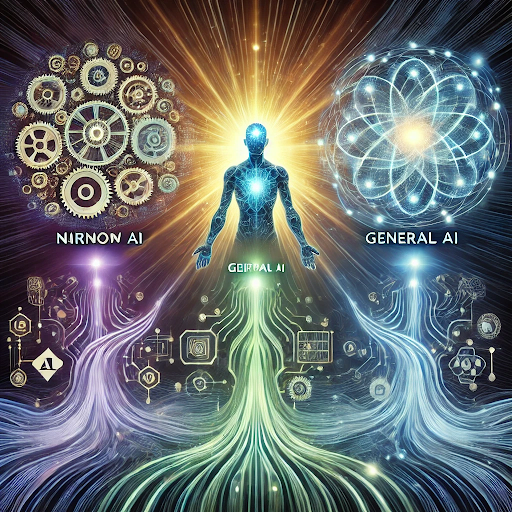"Understanding AI: From Narrow AI to Superintelligence" , "Exploring the Types and Branches of Artificial Intelligence" , "AI Unveiled: Machine Learning, Deep Learning, and Beyond", "A Complete Guide to AI: Types, Branches, and Applications". "Artificial Intelligence Explained: The Evolution from Narrow AI to Superintelligence" ."AI Demystified: Key Concepts and Types You Should Know"...
What is AI?
Artificial Intelligence (AI) is the simulation of human intelligence in machines, allowing them to perform tasks that typically require human cognition, such as reasoning, learning, problem-solving, and decision-making. AI systems can improve their performance through experience, making them "intelligent" in that sense.
Types of AI
AI can be categorized into three main types based on their capabilities:
Narrow AI (Weak AI)
Description: This type of AI is designed to perform a single task or a narrow range of tasks. It's the most common form of AI we have today.
Example: Virtual assistants like Siri or Alexa, recommendation algorithms on Netflix or YouTube, and self-driving cars.
General AI (Strong AI)
Description: This is a theoretical form of AI that can understand, learn, and apply intelligence across a wide range of tasks—just like a human.
Example: If created, General AI could potentially perform any intellectual task a human being can do. However, it doesn’t exist yet.
Superintelligence
Description: This is a form of AI that surpasses human intelligence in every aspect—creativity, decision-making, emotional intelligence, etc. It remains hypothetical and the subject of much debate regarding its safety and ethics.
Example: Science fiction often depicts superintelligent AIs, but no real-world examples exist.
Branches of AI
AI is a vast field, and some of its important branches include:
Machine Learning (ML)
Description: Machine Learning is a subset of AI that involves training machines to learn from data without being explicitly programmed. It focuses on developing algorithms that can analyze and learn from patterns in data.
Example: Spam detection in emails, image recognition, recommendation systems.
Deep Learning (DL)
Description: Deep Learning is a subset of Machine Learning that uses artificial neural networks with many layers (hence "deep"). It is particularly powerful for tasks like image and speech recognition.
Example: Self-driving cars, language translation, facial recognition.
Natural Language Processing (NLP)
Description: NLP enables machines to understand, interpret, and respond to human language. This field includes tasks like translation, sentiment analysis, and chatbots.
Example: Google Translate, ChatGPT.
Robotics
Description: Robotics involves creating intelligent machines that can interact with the physical environment. AI in robotics allows for tasks like automation, navigation, and human-machine interaction.
Example: Industrial robots, autonomous drones, and robotic assistants.
Computer Vision
Description: This branch enables machines to interpret and understand visual information from the world, such as images or videos.
Example: Facial recognition systems, autonomous vehicle navigation, and surveillance systems.
Machine Learning (ML)
ML is a branch of AI that focuses on creating algorithms that allow machines to learn from data and make decisions or predictions without explicit programming. The process involves feeding large amounts of data into the system and enabling it to adjust its operations based on the patterns it finds.
Types of Machine Learning:
Supervised Learning:
Description: In supervised learning, the model is trained on labeled data, meaning that each input has a corresponding correct output.
Example: Predicting house prices based on historical data of house sales.
Unsupervised Learning:
Description: The model is given data without explicit labels and must find patterns or structures in the data.
Example: Customer segmentation in marketing.
Reinforcement Learning:
Description: The model learns by interacting with an environment and receiving feedback in the form of rewards or penalties.
Example: AI in gaming, where the AI learns to win by maximizing rewards.
Deep Learning (DL)
DL is a subset of ML that focuses on using neural networks with many layers (deep networks) to perform complex tasks like image classification, speech recognition, and more. The architecture mimics the human brain's neuron connections, allowing the system to process and learn from large amounts of unstructured data, such as images or voice recordings.
Key Characteristics:
Requires vast amounts of data for training.
Utilizes complex neural networks with multiple layers.
Excels in areas like image recognition and natural language processing.
Key Information About AI
Current Use of AI:
AI is embedded in many aspects of daily life, including virtual assistants (e.g., Google Assistant), recommendation systems (e.g., Netflix, Spotify), and in fields like healthcare, finance, and autonomous driving.
AI in Healthcare:
AI is revolutionizing healthcare by enabling faster diagnoses, predictive analytics, and personalized medicine. AI algorithms can analyze medical images and predict diseases, assisting doctors in making more informed decisions.
AI Ethics:
As AI becomes more powerful, there are significant ethical considerations, such as bias in algorithms, job displacement, and the potential for misuse (e.g., surveillance and data privacy issues).
Future of AI:
AI is likely to advance towards more complex tasks such as autonomous systems in space exploration, fully autonomous vehicles, and superintelligence, though the latter remains speculative and controversial.



Comments
Post a Comment